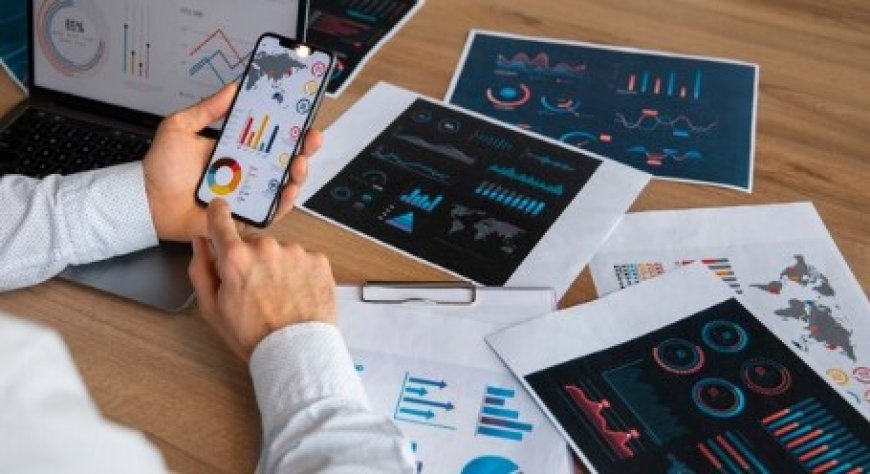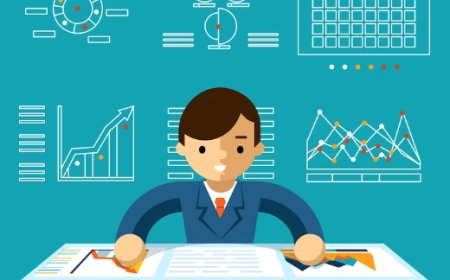The Essential fundamentals of Data Science
Explore the essential concepts of Data Science. Learn key principles, techniques, and applications in this comprehensive guide.

Data science has become indispensable in today's world, revolutionizing industries and driving decision-making processes. From healthcare to finance, every sector relies on data-driven insights to stay competitive and relevant. Understanding the fundamentals of data science is crucial for anyone looking to navigate this rapidly evolving field.
Data science encompasses various disciplines, including statistics, computer science, and domain knowledge. It involves collecting, analyzing, and interpreting large volumes of data to extract meaningful patterns and insights. Key concepts include data cleaning, exploratory data analysis, machine learning, and data visualization techniques.
Understanding Data Science
A. Definition and Scope:
Data Science involves analyzing large amounts of data to uncover insights and solve complex problems. Its scope spans various industries, from healthcare to finance, where data-driven decision-making is crucial for success. Data scientists use a combination of statistical analysis, machine learning, and domain expertise to extract meaningful patterns from data.
B. Key Components:
-
Data Collection: This is where we gather data from different places like databases, websites, or sensors. It's important to get the right data that matches what we want to study.
-
Data Cleaning and Preprocessing: After collecting data, we need to clean it up. This means fixing mistakes, filling in missing values, and making sure everything is consistent and ready for analysis.
-
Exploratory Data Analysis (EDA): EDA is about looking closely at the data to find patterns and trends. We use graphs like histograms or scatter plots to see what the data can tell us. EDA helps us understand the data better and find any problems, like outliers.
-
Statistical Analysis: This involves using math to analyze the data and draw conclusions. We might test ideas with hypothesis testing or make predictions with regression analysis. Statistical analysis helps us make sense of the data and make informed decisions.
-
Machine Learning: Machine learning is like teaching computers to learn from data. We use algorithms to build models that can predict or make decisions without being told exactly what to do. This helps us find patterns in the data and make predictions for the future.
-
Data Visualization: Data visualization means showing the data in pictures or graphs. This helps us understand the data better and communicate our findings to others. We use different types of charts and graphs to make the data easy to understand.
Data science brings together ideas from different fields like math, computers, and specific topics. It's like mixing ingredients to make something new. By using these different ideas, data scientists can understand data better. They can solve puzzles like predicting the weather or figuring out what people want to buy. It's a powerful tool that helps businesses and researchers make smart decisions and discoveries.
Data collection techniques and storage management
Data can come from many places. It could be from online sources like websites or social media, from surveys or questionnaires, or even from sensors like those in smart devices or machines. These sources provide a variety of information that can be valuable for analysis. There are different ways to get data. This could be through manual entry, where someone enters data into a computer. Or it could be automated, like using software to collect data from websites. Sometimes, sensors are used to gather data from the environment automatically.
Once data is collected, it needs to be stored and managed properly. This could mean saving it in a database or using cloud storage. Data also needs to be organized and labeled so it can be easily found and used later. Good data management helps ensure data is secure and accessible when needed.
Data Cleaning and Preprocessing
Data cleaning is crucial because it ensures that the data used for analysis is accurate and reliable. Without proper cleaning, errors and inconsistencies in the data can lead to incorrect conclusions and decisions. Cleaning data helps improve the quality of analysis and enhances the trustworthiness of results.
Data Cleaning Techniques
Data cleaning techniques involve identifying and fixing errors, duplicates, and inconsistencies in the data. This could include removing duplicate records, correcting spelling mistakes, or standardizing formats. Techniques vary depending on the type of data and the specific problem being addressed.
Data Preprocessing Steps
-
Handling Missing Values:
Missing values are common in real-world datasets and can affect the accuracy of analysis. Techniques for handling missing values include imputation (replacing missing values with estimates) or deletion (removing records with missing values).
-
Data Transformation:
Data transformation involves converting data into a suitable format for analysis. This could include scaling numerical features, encoding categorical variables, or transforming variables to meet the assumptions of statistical models.
-
Outlier Detection and Removal:
Outliers are data points that are significantly different from the rest of the data. Outlier detection techniques help identify these anomalies, which can then be removed or adjusted to improve the quality of the analysis.
Exploratory Data Analysis (EDA)
Exploratory Data Analysis (EDA) is a method to examine and understand data using graphs, tables, and basic statistical summaries. It helps to find patterns, trends, and anomalies in the data before deeper analysis. EDA aims to understand data by spotting patterns, trends, and relationships. Analysts use it to find important factors, unusual data points, and ideas for further study.
There are some common EDA techniques, including summarizing the data using descriptive statistics like mean, median, and standard deviation. It also involves examining the distribution of variables, exploring correlations between variables, and identifying potential data issues such as missing values or outliers.
Data visualization for EDA
EDA is a critical step in the data analysis process, aiming to understand the data's characteristics and uncover insights using descriptive statistics and visualizations like histograms, scatter plots, box plots, and heatmaps. Here are some of the data visualizations for EDA :
-
Histograms: Histograms are used to visualize the distribution of a single variable. They display the frequency or count of data points within different intervals, helping to identify patterns such as peaks or clusters.
-
Scatter Plots: Scatter plots are used to visualize the relationship between two variables. Each data point is plotted on a graph with one variable on the x-axis and the other on the y-axis, allowing analysts to identify patterns or correlations between the variables.
-
Box Plots: Box plots display the distribution of a single variable and show key summary statistics such as the median, quartiles, and outliers. They provide a visual summary of the data's central tendency and variability.
-
Heatmaps: Heatmaps are used to visualize the relationship between two categorical variables or one categorical and one numerical variable. They use color gradients to represent the frequency or count of observations within different categories, allowing analysts to identify patterns or associations between the variables.
Statistical Analysis
A. Statistical Methods in Data Science:
Statistical methods in Data Science help understand data to make predictions. They include techniques like regression (predicting outcomes), clustering (grouping similar data), and classification (assigning labels). These methods find patterns and relationships in the data.
B. Descriptive Statistics:
Descriptive statistics summarize the data's main features. They include measures like average (mean), middle value (median), and how spread out the data is (standard deviation). These stats give a quick idea of what the data looks like.
C. Inferential Statistics:
Inferential statistics predict things about a whole group based on a smaller sample. Techniques like hypothesis testing (checking if a guess is true) and confidence intervals (how confident we are in our guess) help understand how well predictions hold up.
D. Hypothesis Testing:
Hypothesis testing checks if our ideas about data are likely true. We set up a guess (a null hypothesis) and see if our data supports or rejects it. It helps us decide if our findings are meaningful or just a random chance.
Machine Learning
Machine Learning teaches computers to learn from data and make decisions. It's like teaching a child to recognize animals by showing them pictures.
Supervislearninging uses labeled data. Regression predicts outcomes like house prices, while classification assigns labels like spam or not spam to emails, and unsupervised Learning works with unlabeled data. Clustering groups similar data points, and dimensionality Reduction simplifies data while keeping its meaning. This checks how well the model works and splits data, trains it, and tests it to make sure it can handle new data accurately.
Data Visualization
Importance of Data Visualization:
Data Visualization is crucial as it helps in presenting complex data simply and understandably. It allows us to uncover patterns, trends, and relationships in the data quickly, making it easier to interpret and communicate insights effectively.
Types of Data Visualizations:
-
Bar Charts: Bar charts represent data with rectangular bars, where the length of each bar corresponds to the value it represents. They are commonly used to compare categories of data.
-
Line Charts: Line charts show data points connected by lines. They are useful for displaying trends over time or comparing changes in data over different categories.
-
Pie Charts: Pie charts divide data into slices to represent proportions. They are effective for showing parts of a whole and comparing the relative sizes of different categories.
-
Scatter Plots: Scatter plots display individual data points as dots on a graph. They are used to visualize relationships between two variables and identify correlations.
Tools for Data Visualization:
There are various tools available for data visualization, including Tableau, matplotlib, ggplot2, and Microsoft Power BI. These tools offer user-friendly interfaces and a wide range of features to create interactive and visually appealing visualizations.
Practical Applications of Data Science:
Industry use cases:
Data science finds diverse applications across industries like finance; it aids in risk assessment, detecting fraudulent activities, and refining trading strategies. Healthcare benefits from data science through improved diagnosis, treatment planning, and drug discovery processes. Meanwhile, in marketing, it enables precise customer segmentation, targeted advertising, and enhanced campaign optimization.
Real-world Examples:
-
Predictive Analytics: Businesses use predictive analytics to forecast trends and customer behavior.
-
Customer Segmentation: Companies group customers based on similarities to personalize marketing efforts.
-
Fraud Detection: Data science detects anomalies to prevent fraud in financial transactions.
Challenges and Future Trends in Data Science
Data science faces challenges like ensuring the ethical use of data, protecting privacy, and adapting to emerging technologies. However, it also presents opportunities for advancements in various fields, requiring continuous learning and innovation for progress.
A. Ethical Considerations: Data science raises questions about fairness, privacy, and honesty in using data responsibly.
B. Data Privacy and Security: Keeping data safe and private is critical to preventing breaches and unauthorized access.
C. Emerging Technologies: New technologies like AI and blockchain are shaping data science's future, offering both opportunities and challenges.
D. Opportunities for Advancement: Data science holds promise for improving healthcare, cities, and more, but ongoing learning and innovation are essential for progress.
In conclusion, understanding the basics of data science is vital for anyone interested in working with data. Mastering these fundamentals provides a solid foundation for analyzing data effectively and making informed decisions. It's an ongoing journey of learning and exploration, with endless opportunities for growth and contribution to the field. Keep learning, experimenting, and applying these concepts to unleash the power of data science in solving real-world problems.




































